
1.
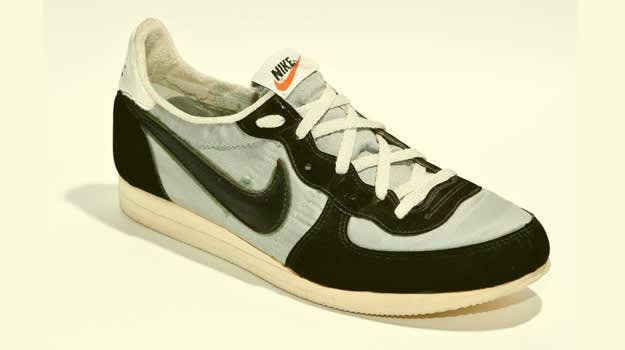
Running as a sport seems like it would have a longer story in modern history, but the most important developments have been made in the past five decades.
From Nike’s creative waffle iron approach to the latest and greatest suspension midsoles from Mizuno, Sneaker Report has blasted through the sports marketing hype to take a look at the best running shoes athletic brands have to offer. Whether these runners paved the way for future greatness with innovative technology and breakthrough ideas or are simply your current favorites, click through for some extra inspiration to hit the road this week with The 100 Best Running Sneakers of All Time.
RELATED: FIRST LOOK: Mizuno Wave Rider 16
RELATED: The 10 Best Sneaker for First Time Marathoners>/a>
RELATED: The 10 Best Running Shoes of 2013
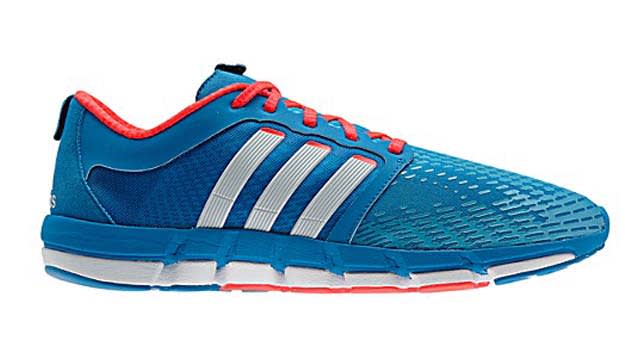 No. 100 - adidas Adipure Motion Shoes
No. 100 - adidas Adipure Motion Shoes
Year Released: 2012
Released this past summer, adidas continues to ride the barefoot train with the release of the Adipure Motion, along with the Gazelle and Adapt models. The material upper reminds us of the earlier attempts to make uppers super lightweight, Nike's Air Flow and Air Current specifically, but the range of sole technology used in this "natural running" line is what made this collection unique for adidas. The super low drops put this kick on the map, but we don't have much hope for this kick to hold up in the long haul.
2.
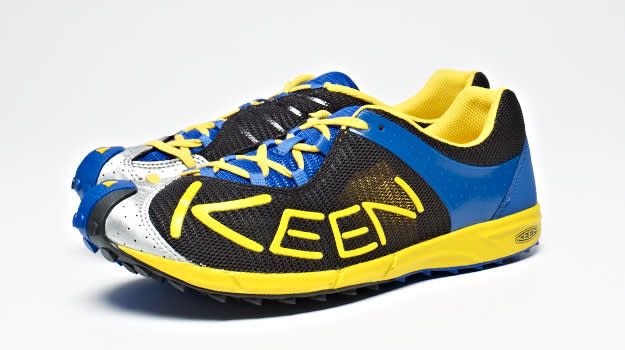
No. 99 - Keen A86
Year Released: 2011
Keen proved themselves a contender with this sneaker. The brand known for hiking boots and cozy socks prove that trail running shoes can be just as lightweight and comfortable as their road running equivalent. Made of an ultra-light synthetic and mesh material, the A86TR is a breathable kick with a compression mold PU midsole and a non-marking rubber outsole comprised of 3MM multidirectional traction lugs.
RELATED: REVIEW: Keen A86 TR 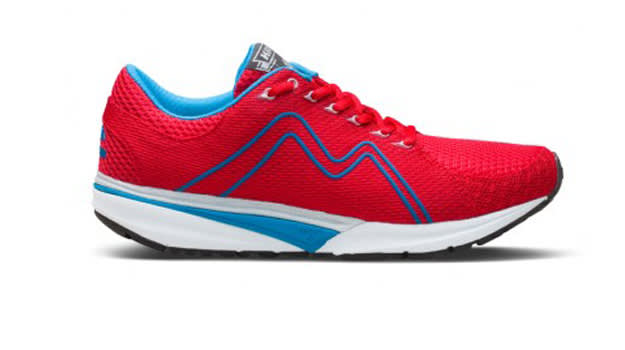
No. 98 - Karhu Fast 3
Year Released: 2011
The brand boasts nine Olympic gold medals in just eight years, thanks to Paavo Nurmi in 1920, today Karhu continues to equip athletes with a new approach midsole construction. Karhu employs a patented fulcrum technology that aims to return runner's energy into efficient forward momentum since 2000, the exaggerated shape of the blown rubber / carbon rubber outsole encourages runners to make the best use of every stride. {C} 
No. 97 - Vibram FiveFingers Bikala
Year Released:
The Bikila was a breakthrough running shoe for Vibram, serving to promote a healthy, more efficient forefoot strike with a super slim 3mm polyurethane insole that is thickest under the balls of the foot to help forefoot-strike running forms. This wasn't the first toe separation slip on be embrace by the barefoot running community, but it was the first shoe build to serve this specific market with running details like 3M reflective touches and a padded collar and topline for comfortable wear.
3.

No. 96 - adidas adiZero Feather 2.0
Year Released: 2012
This sneaker may already have hit the sale rack, but this running shoe is a balancing act of support and lightweight construction. The Adiprene in the forefoot and the Adiwear outsole offers durablilty in the outsole. This is shoe is winning in the race to lightweight kicks, without boasting an ultra barefoot heel drop. 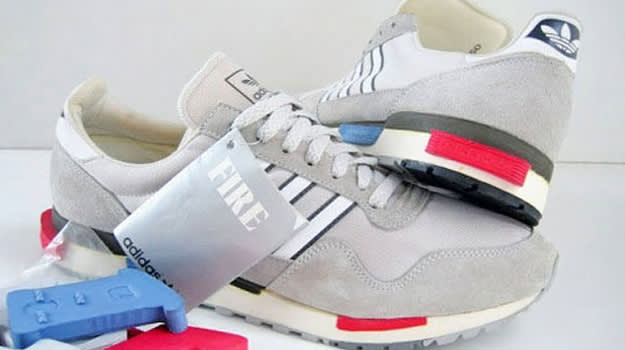
No. 95 - adidas Fire
Year Released: 1986
If the millimeter deep heel drops and flexible outsoles of today seem like an gimmick, this one will blow your mind. The adidas Fire followed the LA Trainer's peg system with removable pads to customize the level of cushioning your run requires. Not a running shoe for the masses even in the late '80s, the focus on customized cushioning was a sign of the times. 
No. 94 - Saucony Triumph 10
Year Released: 2012
The 10th generation of the Triumph features an overlay pattern with a supportive layer embedded in between mesh layers, to provide a more refined fit that looks clean on the road. Not as much of a departure from the Triumph collection as the 9, the 10 made minimal changes to introduce the lightest model that boasts a responsive midsole. 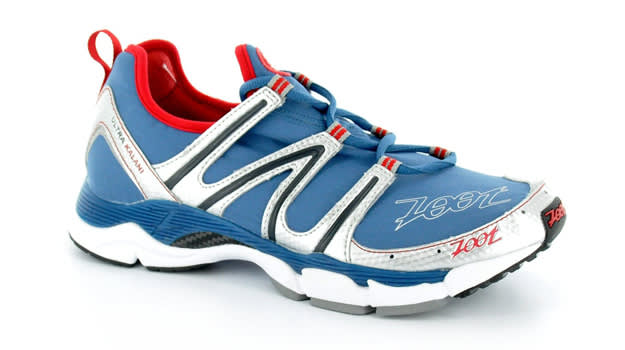
No. 93 - Zoot Kalani 2.0
Year Released: 2010
Zoot is a triathlete's best friend. The brand boasts what looks to be an endless list of Ironman Champions and Olympic Triathlons with good reason, the pull tabs make this kick effortless when it comes to transitions. The glove-like upper construction is built on a CarbonSpan+ midole and toe spring for a balanced kick. {C} 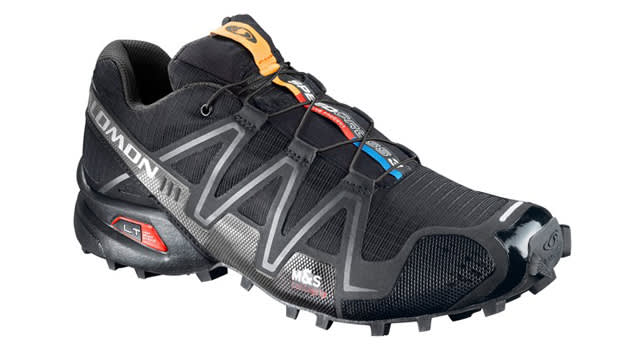
No. 92 - Salomon Speedcross 3
Year Released: 2012
Salomon's running collection mostly focuses on running on less than suitable terrain, and while the Speedcross 3 would be best in slippery conditions, the Ortholite sockliner and the molded EVA midsole keep this sneaker in the race. 
No. 91 - Brooks Ghost 5
Year Released: 2012
The Ghost 5 is the Brooks Running sneaker for entry level runners seeking a little bit of extra stability. Taking the best components of the 3 and 4 designs, the best quality of the 5 is the responsive ride that is delivered despite this stable frame. Includes the "Caterpillar Crash Pad" and anatomical Brooks DNA for a custom cushioned feel.
RELATED: REVIEW: Brooks Running Ghost 5 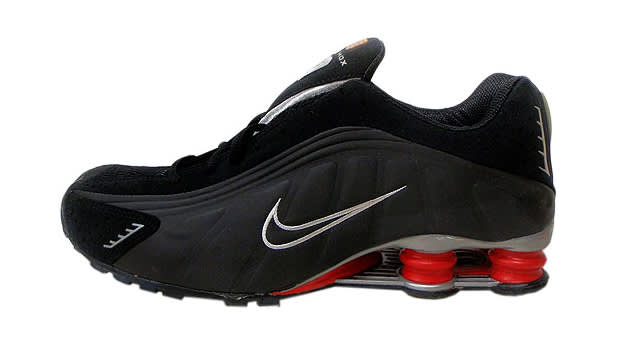
No. 90 - Nike Shox R4
Year Released: 2000
Designed by Bruce Kilgore (of AF1 and Air 180 fame) and Sergio Lozano, when Nike Shox technology was introduced in 2000, it was said that the Shox technology had been in the oven for sixteen years. Out of the three editions released, the Shox R4, BB4, and the XRT, the R4 was the most successful as a runner with significant return upon heel strike. Wit responsive cushioning supplied by a flexible Air-Sole unit and Nike Shox technology created that extra bounce, the Nike Shox R4 was the start for something new for responsive kicks from the Swoosh. 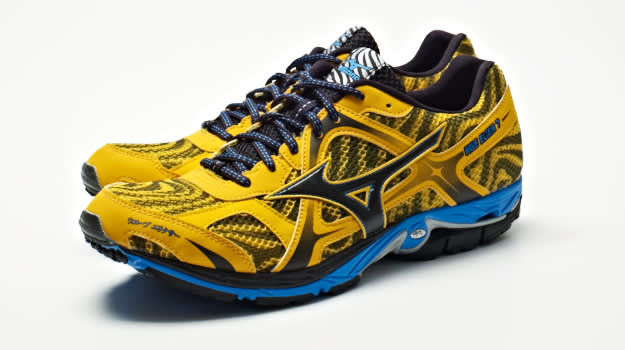
No. 89 - Mizuno Wave Elixir 7
Year Released: 2012
The seventh generation of the Wave Elixir is the lightest, fastest yet with a blown rubber forefront that provides an impressive amount of cushioning without sacrificing that super light 9.3 oz frame. Plus the all-over print is a welcomed change in a time where neon colorways are getting tired and need a textural update. 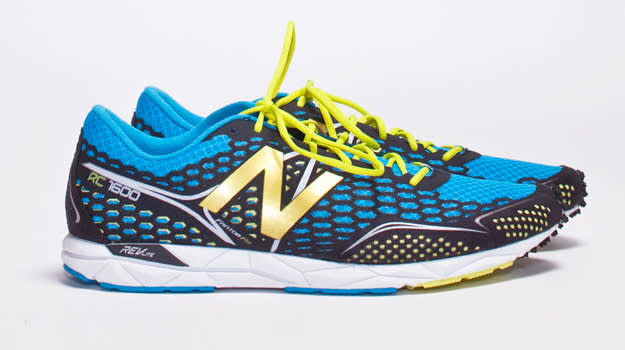
No. 88 - New Balance 1600 Marathon
Year Released: 2012
Built for some major mileage, the New Balance REVlite kick is stocked with the most cushioning in under 5.8oz. With a FamtonFit engineered upper that fuses two super thin materials with a no-sew process, the REVlite kicks is kept light with every layer. 
No. 87 - Nike Air Rift
Year Released: 1995
The minimal trend in running footwear actually began decades ago. The original Air Rift release was inspired by Kenyan barefoot runners from Rift Valley, a small town where many Olympic hopefuls go to train on the high altitude cinder track. Nike created a split toe for more emphasis on "barefoot" feel while the midsole remained a bit chunkier than today's minimal kicks. {C} 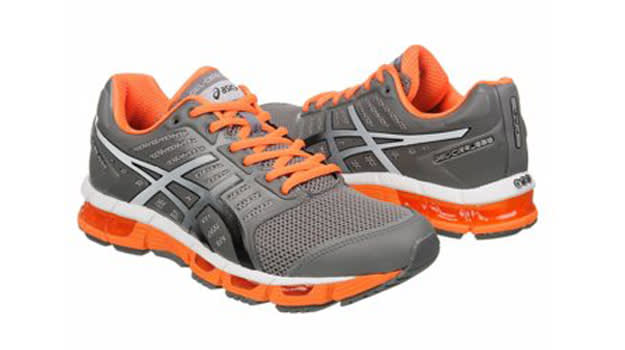
No. 86 - Asics GEL-Cirrus33 2
Year Released: 2013
The Asics GEL-Cirruss33 2 hasn't hit the market yet, but following the successful release of the original, it's safe to say this spring model will be a hit. The Cirrus33 2 features the most of Asics' proprietary GEL technology for optimal cushioning without adding extra weight at 11.8 ounces. We're eager to see how the GEL-Cirrus33 collection evolves from here. {C} 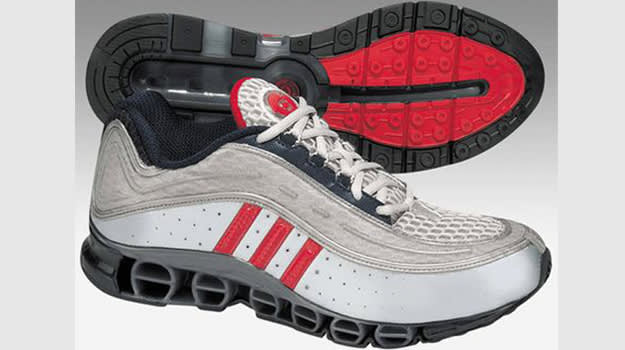
No. 85 - adidas Ultraride
Year Released: 2004
This is the part where adidas attempts to build a foamless sole. The TPU material used to build the vertical tubular structure seen above doesn't break down over time like running staple medium, foam, so you can see where adidas was going with the material switch-up. While no other versions exist of the Ultraride, it's easy to see it's influence later with similar midsole technology?? 
No. 84 - Zoot Ultra Kiawe
Year Released: 2012
Zoot has made the list again by supplying a running shoe that can easily transition for triathletes looking to shave off a few seconds. Created in conjunction with Ironman and ITU World Champions, this triathlon running shoe is made to meet the demands from every type of runner from pro to weekend warrior. 
No. 83 - Under Armour Charge RC Storm
Year Released: 2011
Under Armour launched their first footwear collection in 2005, perhaps earning the most success in the running market so far with the UA Charge RC Storm. Establishing the brand's look with the wide set laces on the upper and the interesting patterning to create the mid foot shank, the Storm is a one of a kind running kick that created the platform for the recently released UA Spine Running collection. {C} 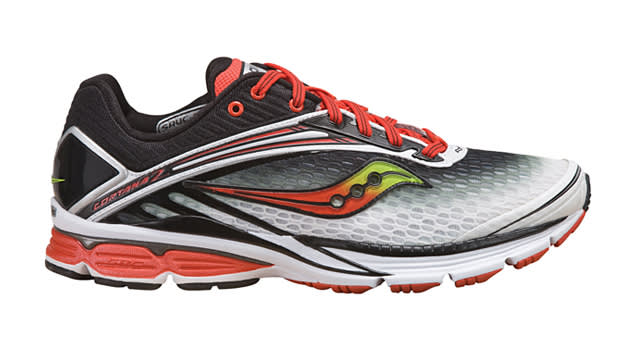
No. 82 - Saucony Cortana 2
Year Released: 2012
The original Cortana was a happy surprise for neutral runner that were looking for something new, so you can only guess how the community has responded to the sequel kick. Not far off from the OG model, the 2 has a slightly re-crafted upper that slims the kick by a full ounce that keeps the formerly traveling tongue in its place. A staple shoe that should be apart of any runner's rotation. 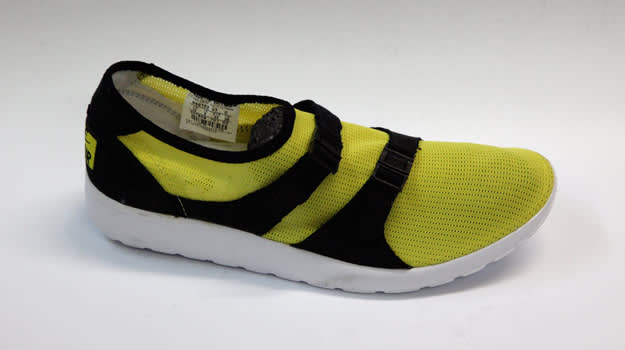
No. 81 - Nike Air Sock Racer
Year Released: 1984
Still crazy after all these years. A slip on racing flat with a full length Nike Air midsole was a bold move in the mid '80s running market. The one piece upper was made of a synthetic mesh upper that by today's standard would be considered a recipe for stagnent sweat. But these were considered good enough for Ingrid Kristiansen to win the '86 Boston Marathon and bring them along to the Olympic Trials the following year. This was Nike's way of saying that the Swoosh was now paying extra attention to the upper, as the outsole had been the biggest story of the early '80s. {C} 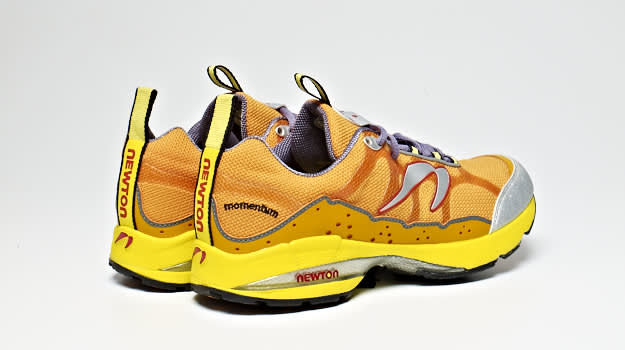
No. 80 - Newton Momentum
Year Released: 2011
Newton Running is a pioneer in the industry when it comes to focusing on heel-to-toe drop and the benefits that can be derived from inspiring a mid foot strike. The all-terrain Momemtum for the brand is no different, weighing in a 11.2 ounces with a 4.5mm crop, this high traction kick is a sign of diversity for the specialty sneaker brand. {C} 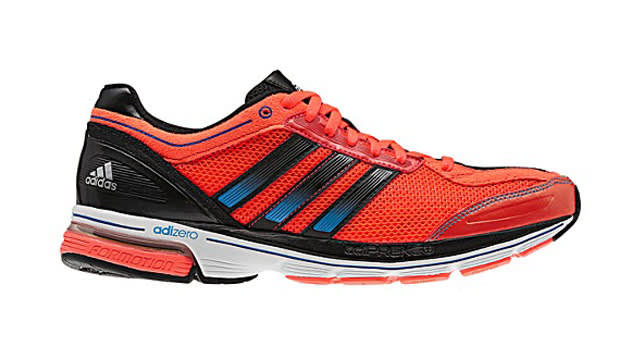
No. 79 - adidas adiZero Boston 3
Year Released: 2012
It's been said that it is hard to run slow in the Boston 3s. Named accordingly as most wears are ambitious enough to qualify for the namesake's annual marathon, the most competitive event in the country. This Adizero kick maintains its predecessor's lightweight frame while providing a comfortable, record breaking ride. Show up at any local race and you'll spot a few pairs for good reason. {C} 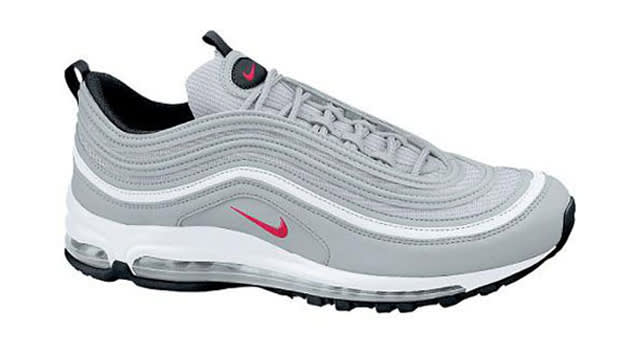
No. 78 - Nike Air Max 97
Year Released: 1997
Running shoes are usually inspired by the shape of other fast moving objects. The shape of the Air Max 97 was inspired by non other than a Japanese bullet train. With a full-length visible Air Unit and the three tiered reflective stripes for nighttime runners, the '97 was designed to take on the impact of a middle to long distance run. 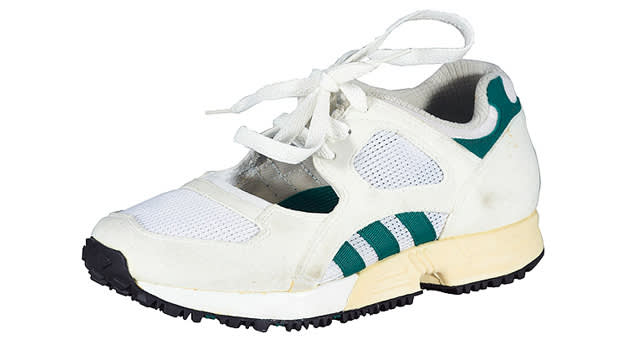
No. 77 - adidas Equipment Racing
Year Released: 1991
The adidas Torsion System that is still used today (albeit tweaked) was a key performance element in the adidas Equipment Racing sneakers. Released as one of a four part range, the cut out toe box allowed the foot to breathe as well as making a unique running sneaker to go along with the other training high and mid top sneakers apart of the pack. 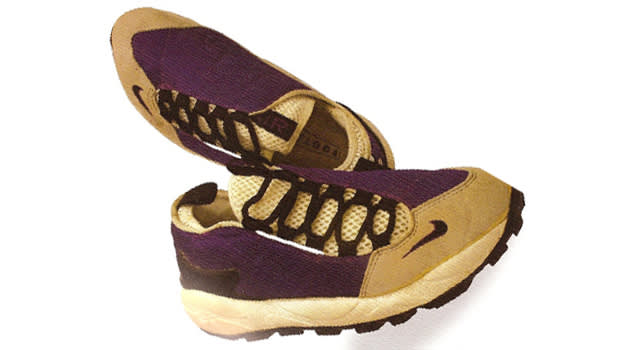
No. 76 - Nike Air Footscape
Year Released: 1995
Released in a pinnacle year for Nike, the Air Footscape featured an asymmetrical lacing system that looks commonplace these days, seen most on trail kicks like the aforementioned Keen A86. The shape of this shoe was a little more unexpected, following the natural contours of the foot so well that it's easy to see that Nike had their sights on a more "natural" ride years ago. {C} 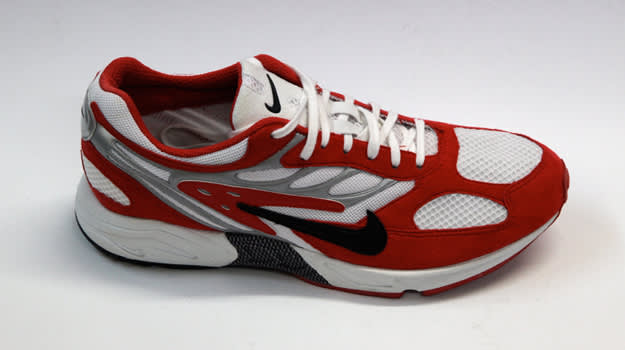
No. 75 - Nike Ghost Racer
Year Released: 1991
The Ghost Racer weighed in at an impressive 7.9 ounces, this equipped kick was built for heavy strikers ready to face a marathon or longer. Featuring a full-length Phylon midsole, Duralon outsole, and finished off with a Zoom Air unit in the heel, this may not be a relevant kick to today's running standards, but provides an important look into the evolution of running kicks. 
No. 74 - Mizuno MZ-84
Year Released: 1983
Mizuno has always been a trail blazer of a brand when it comes to focusing on performance. The MZ-84 offered a customizing system similar to what other brands were offering at the time, but the level of detail here is impressive. The unassuming sneaker maintains a simple physic despite the complicated options on the inside. 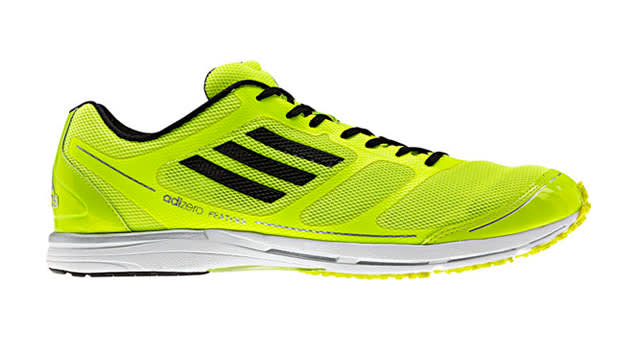
No. 73 - adidas adiZero Hagio
Year Released: 2011
The traction on the forefoot's outsole is the first thing you'll see and feel on the florescent Hagio racing sneaker. This well-ventilated kick doesn't sacrifice weight for a gracious toebox at a total of 6 ounces, supplying another great example of the niche category of running sneakers, light enough to be considered a racer, but tough enough for the long haul. {C} 
No. 72 - Nike Free 5.0
Year Released: 2004
Deep flex grooves are made to mimic the natural motion of your foot, with an upper to float along with it. The 5.0 sole is made for those who aren't fully ready to commit to the ground, but still look for that extra feel in their stride.
4.
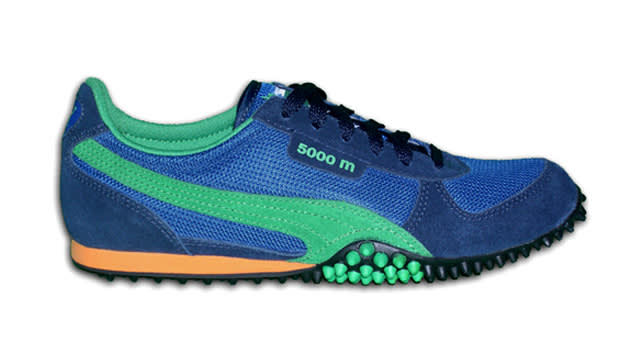
No. 71 - Puma 500M
Year Released: 1980
The Puma Cross Country came to be the 500M, developed to mimic track spikes with the rubber conical shapes following the contour of this otherwise traditional racing flat. 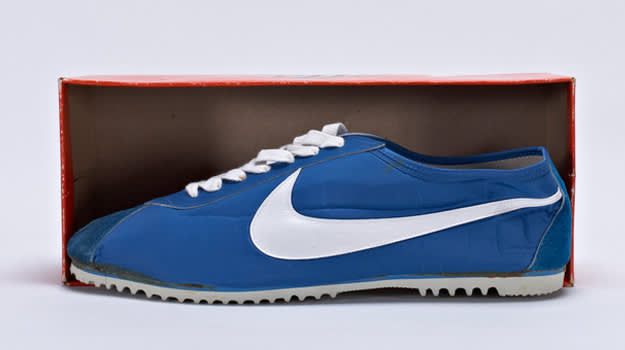
No. 70 - Nike Marathon
Year Released: 1972
This is one of the first Nike shoes to feature a nylon upper and the innovation doesn't stop there. This kick may look simple now but back in the day this was a high innovative racing shoe as the raised heel was inserted to protect heels and joints and absorb shock. The '70s may have not been a bangin' decade for sneaker innovation like the '80s, but the journey had to start somewhere, and this one started with this Japanese manufactured kick. 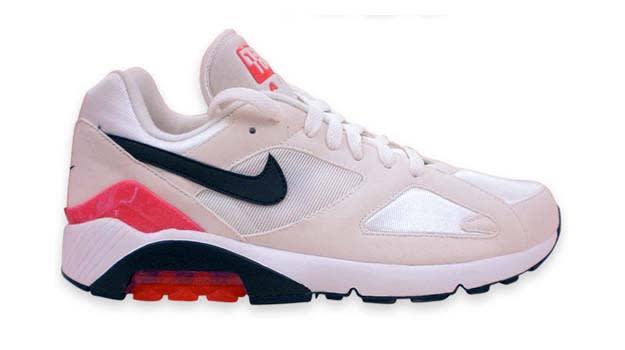 No. 69 - Nike Air Max 180
No. 69 - Nike Air Max 180
Year Released: 1991
The shoe that contained fifty percent more air that the previous releases of Air Max proved their point with a visible exposed outsole, made super durable for hitting the pavement. This is one of many training shoes that made it good enough to hit the hardwood as well, as Charles Barkley rocked this low-cut runner to the 1992 Barcelona Games.
5.
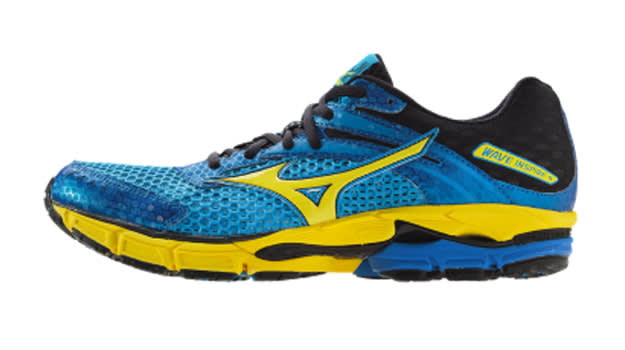
No. 68 - Mizuno Wave Inspire 9
Year Released: 2011
The Wave Inspire 9 made this list as Mizuno has stayed true to offering a running shoe for a variety of runners. The glove-like fit creates a glide of a ride while supplying the right amount of stability for logging longer miles. 
No. 67 - Asics GEL-Excel33 2
Year Released: 2012
The motto for the GEL-Excel33 2 is simple (and one every good road sneaker should follow): "High on performance, ultra-light on weight." This shoe from Asics features a Propulsion Trusstic system that creates tension as the foot enters propulsion stage. The addition of the gait-enhancing Guidance Line technology and a rearfoot GEL cushioning system make it an excellent offer for runners across the spectrum. 
No. 66 - Brooks PureCadence
Year Released: 2010
Runners rejoiced when Brooks Running unveiled the PureProject, promoting a mid foot strike and a more natural feeling gait. The PureCadence was the middle child sneaker of the collection, offering the same lean construction but with a guidance system to support runners that seek a little more stability for their ride. With the PureCadence 2 to hit the shelves soon, it will be interesting to see how fans react to the sequel kick. 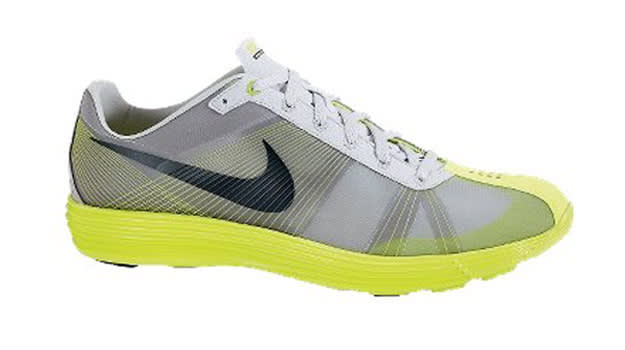
No. 65 - Nike Lunar Racer
Year Released: 2008
The Nike Lunar Racer was here to show us how the Flywire went to work in a 5.5 ounce racer. More stable and practical of a racer than other kicks of its generation, the Lunar Racer struck a great balance of Nike's performance technology in '08.
6.
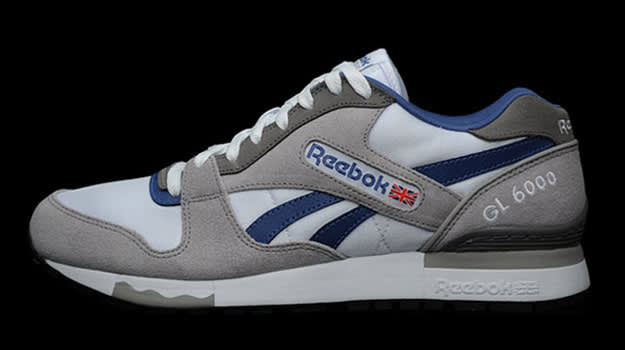
No. 64 - Reebok GL6000
Year Released: 1986
The Reebok GL6000's total support system and a dual-density midsole resulted in instant success for unassuming runners in the mid '80s. The shoe offered the perfect blend of comfort and support without sacrificing in the weight department. And with the shoe's Goodyear Indy 500 rubber outsole, traction was superb.
{C} 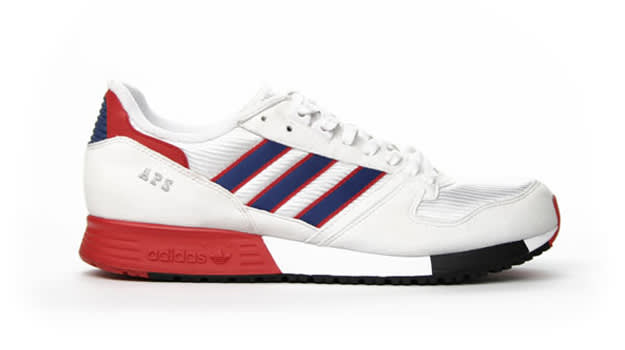
No. 63 - adidas APS
Year Released: 1986
A poster child sneaker for the late '80s, the "APS" somehow stands for "anti-pronation" and "shock absorption system." With a slightly gimmicky customization system, a simple twist of a key controlled the hardness or softness of your midsole as sneakers made efforts to become as multi-functional as the cross training competitors of the time. 
No. 62 - Nike Air Presto
Year Released: 2000
Nike tried something new with the Air Presto, releasing in sizes XS - XXL much like your favorite t-shirt. The similarities don't stop there, the upper was constructed of a four way stretch mesh upper to mimic the lightweight, wicking properties of performance apparel. The outer support cage was also a nice little touch.{C} 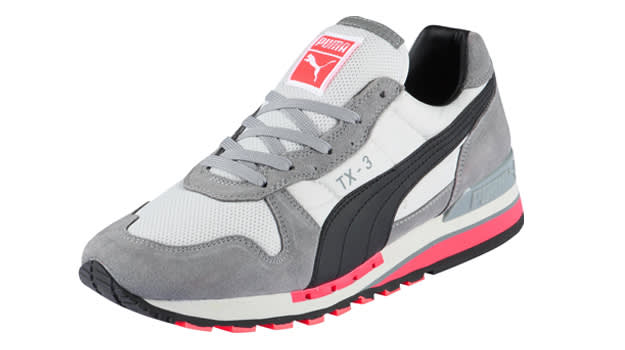
No. 61 - Puma TX-3
Year Released: 1985
The TX-3 was a definitive performance model for the Puma brand. Designed with a serious runner in mind, the kick featured a super dense midsole and a reflective combination on the upper. While we don't see pigskin anymore in our running kicks, paired with mesh for the TX-3 struck a harmonious chord. 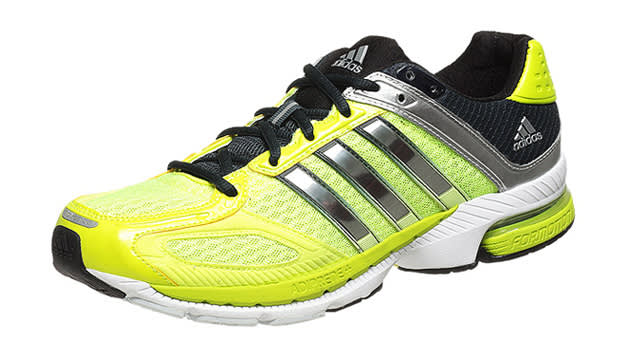
No. 60 - adidas Supernove Sequence 5
Year Released: 2011
The Supernova Sequence 5 is one supportive shoe, with the air mesh upper and adiprene underfoot, this shoe is ready for middle to longer distances. What makes it extra special for runners that need a little extra support is the pro-moderator medial support system that prevents overpronation.
7.
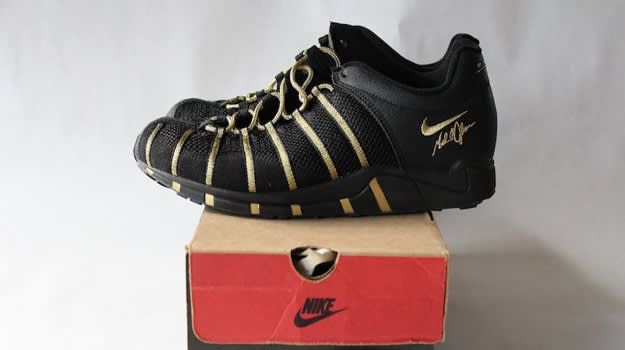
No. 59 - Nike Zoom JST
Year Released: 1998
These crazy looking kicks were originally made for Michael Johnson as a track spike, but transitioned easily in the hands of Tinker Hatfield into a running shoe of the day. With just the right hint of that Michael Johnson x Nike gold magic, these kicks aren't super popular in the history books but were important to the legacy of signature shoes for track and field stars (not a highly common thing).
{C}
No. 58 - Etonic Quasar
Year Released: 1984
Etonic Worldwide isn't a company we mention often on Sneaker Report. While they still do supply a decent variety of performance kicks, the company that had early roots in footwear changed enough hands along the way to lose some edge. The Quasar was a great moment for the brand, with the jogging boom the company took great strides lead the way with a different approach. This included lacing, with an extra long system that wrapped around to your heel for a more dynamic fit. Oh 1984, you were a bizarre time.
8.
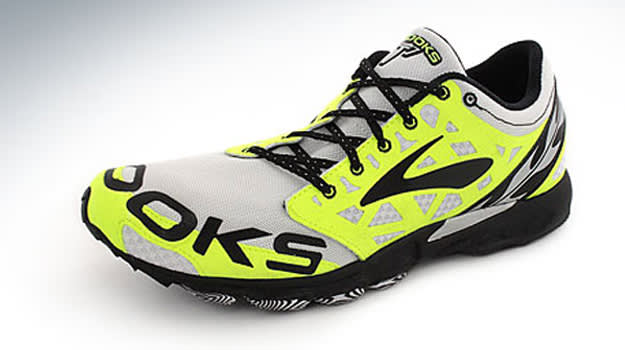
No. 57 - Brooks T7 Racer
Year Released: 2011
Brooks Running has the race covered for runners seeking a closer relationship with the road. These kicks have been a favorite of ultra marathoners and have a provided a popular option for road racers in the past year, placing it in the middle of our list. The lightweight recipe is a winner, though we continue to encourage less experienced runners to start off slow with this minimal sole.
9.
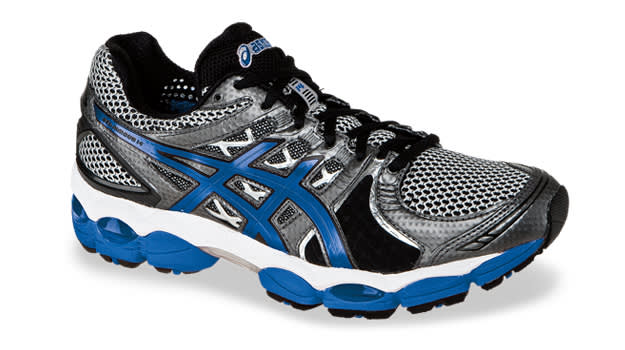
No. 56 - Asics GEL-Nimbus 14
Year Released: 2010
The great thing about Asics in the past few years is their intent to churn out new models while striving to keep the integrity of the original sneaker collection intact. As the numbers go up, the weight goes down. This is yet again proved in the GEL-Nimbus 14 with a sleeker profile, still equipped with the Guidance Line influence outsole and the heel clutch system that keeps long distancers happy. No doubt this shoe will get lighter and fancier, but so far the 14 is rating high on our list of ready-to-go runners.
10.
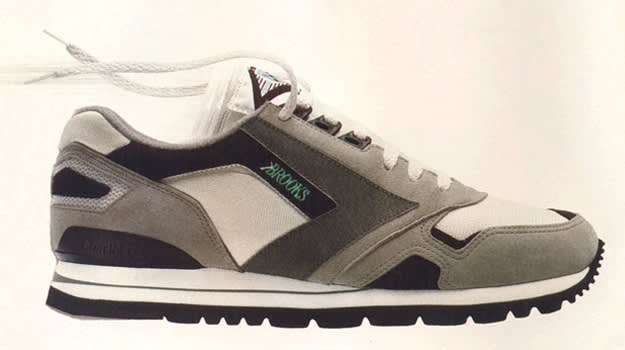
No. 55 - Brooks Chariot
Year Released: 1983
A later cousin to the Brooks Hugger, the Chariot dropped the wrap-around-the-ankle lacing system seen in some model around that time but kept the sleeker, simpler look of an early '80s running shoe. Rolling your ankle was a major concern of the time, with stability-providing midsoles that offered "rollbars" that slanted feet inwards to eliminate any chance of pronation. Talk about stacks on stacks on stacks... this shoe had multiple layers.
{C}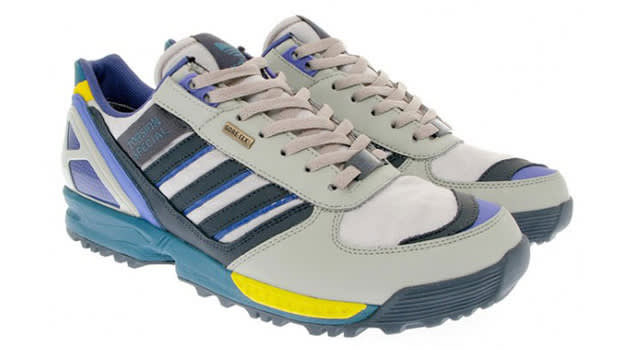
No. 54 - adidas Torsion Special
Year Released: 1990
The Torsion Special from adidas was one of those shoes that wasn't appreciated for its total worth until it was tried on. Designed as a road/trail hybrid, the sneaker featured Gore-TEX technology for all-weather use. The Torsion system in the mid-foot areas gave the sneaker great support and responsiveness.
11.
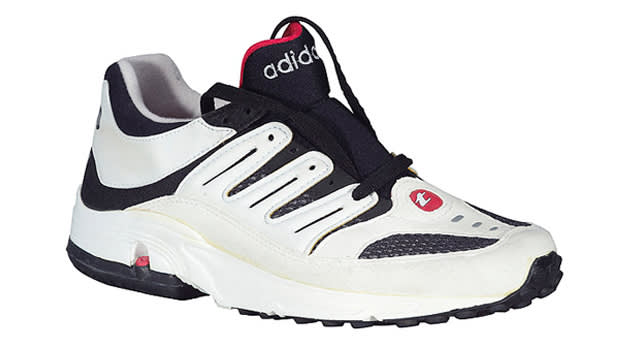
No. 53 - adidas Tubular
Year Released: 1993
Drawing inspiration from car tires, this shoe's Tubular technology allowed runners to customize the level of cushioning in the heel. With the use of a hand-held pump, the sneaker's U-shaped Vibrastop outsole could easily be inflated or deflated according to a runner's personal preference. Talk about total control.
{C}
No. 52 - New Balance 577
Year Released: 1989
If you were in search of a no-nonsense workhorse of a sneaker in the late '80s, the New Balance 577 was it. Today's 557 is a leather walking shoe, but the original 577 of '89 was released admist the other glamourous models that sneakerheads crave this time of year. With an Encap midsole and a lugged outsole for tougher terrain, not to mention that sweet suede and mesh upper, runners of past decades got good-looking kicks too.
12.
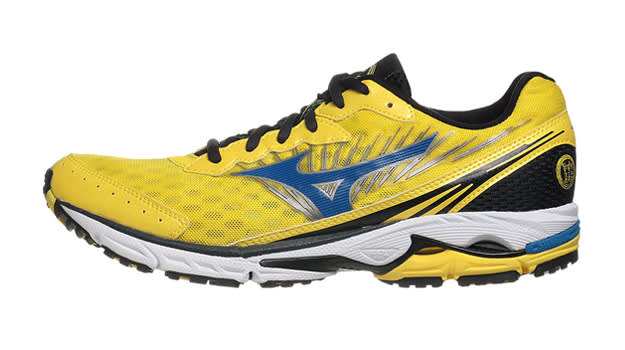
No. 51 - Mizuno Wave Rider 16
Year Released: 2012
We've already gone over how Mizuno's Wave Rider has evolved with runners for the past two decades, now meet its newest rendition with the 16. The heat-bonded-synthetic suede overlays and new mesh materials push it into the running as the new favorite while the popular outsole didn't change much from the 15.
{C}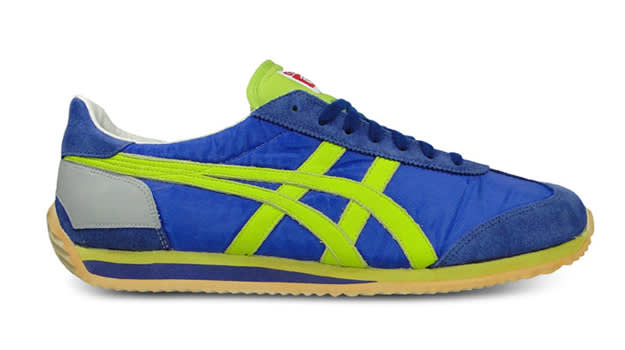
No. 50 - Onitsuka Tiger California
Year Released: 1978
Onitsuka Tiger, surprisingly enough, did not have original roots in running sneakers, but in basketball kicks. Eventually the risk as the first Japanese brand to offer the court kicks caught on, and the Onitsuka Tiger brand went on to create some iconic performance models. This included the "California" version of the Tiger running shoe, built on the platform that was the jogging boom of the late '70s. What better a place to jog then sunny California?
13.
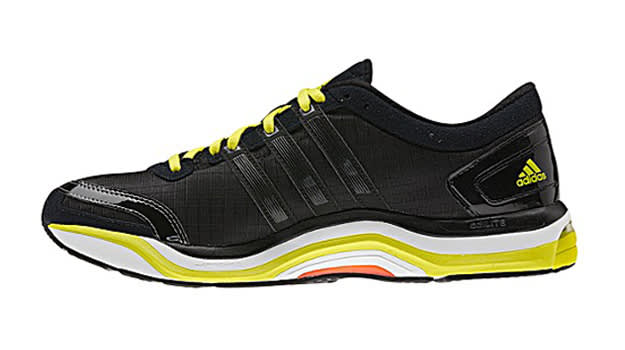
No. 49 - adidas adiZero Aegis 2
Year Released: 2012
adidas has deep roots in running, and they haven't let that foothold go by offering a seemingly limitless variety of running kicks in 2012. The Adizero Aegis 2.0 is the product of a soft landing thanks to the Formotion technology, Adiprene in the forefoot, all adding up to a mere 9.2 ounces. The Aegis makes the cut to our "Best of" list as it's a mixing pot of the best technology that adidas has to offer.
14.
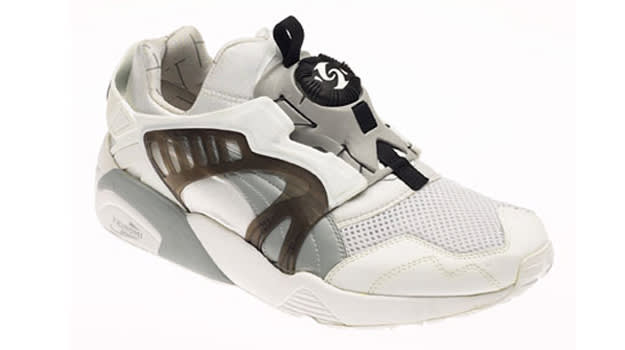
No. 48 - Puma Disc
Year Released: 1994
The fact that we are still using the simple, caveman-like invention of shoe laces for most of our performance footwear is mind boggling. Puma thought so too back in the early '90s, introducing the Puma Disc system. Just a spin of the disc could tighten or loosed your kicks as needed, no knotting included. Despite all of the plastic on top, this was considered a flexible shoe at the time with mesh overlays and Aeroprene integrated throughout.
{C}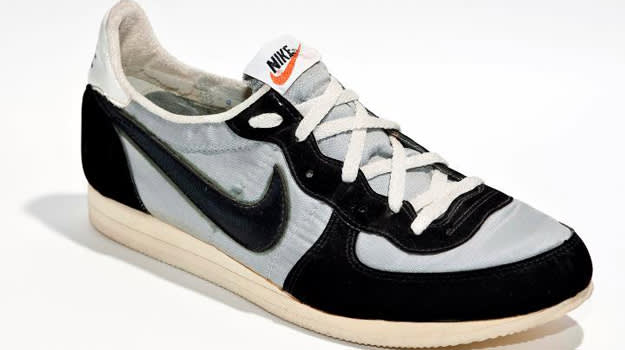
No. 47 - Nike Eagle
Year Released: 1980
A sneaker weighing in at 5.1 ounces is sure to make any runner smile—just what the Nike Eagle did. In the '80s especially, testing a new material from a different industry was rare. The release of the Eagle changed that in a heartbeat. Made in part from a radical new fabric called GEOS (generally used for circuit polishing), the Eagle wasn't just super lightweight, but it was also tougher than the ones made with traditional leather. Runner Alberto Salazar helped cement the Nike Eagle's legendary status by winning the New York marathon back-to-back in 1980-81 in a pair of the kicks.
15.
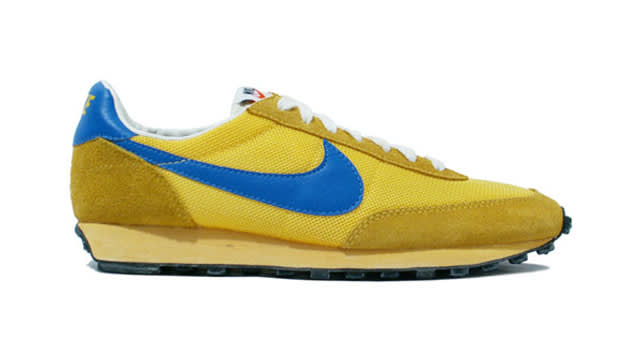
No. 46 - Nike LDV
Year Released: 1978
The late '70s was a winning streak for Nike and their racing flats, with the LDV the Swoosh built up the midsole for the long distance runner. The waffle outsole was well suited for any given trail while mesh upper kept it lightweight.
{C}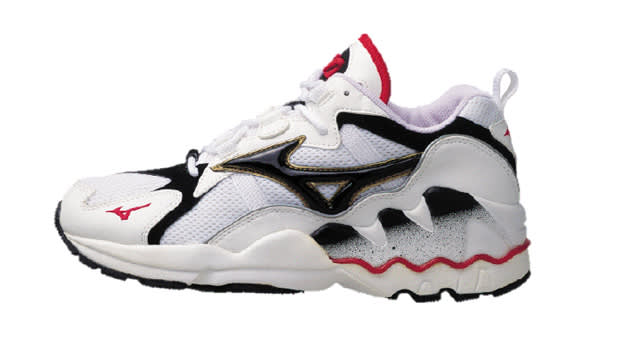
No. 45 - Mizuno Wave Rider
Year Released: 1998
Mizuno churned out the original Wave Rider in '98 at 12.8 ounces, unveiling the first edition of wave technology. This shoe paved the way for the following sixteen editions of the wave rider, of which runners have a lot to be thankful for.
16.
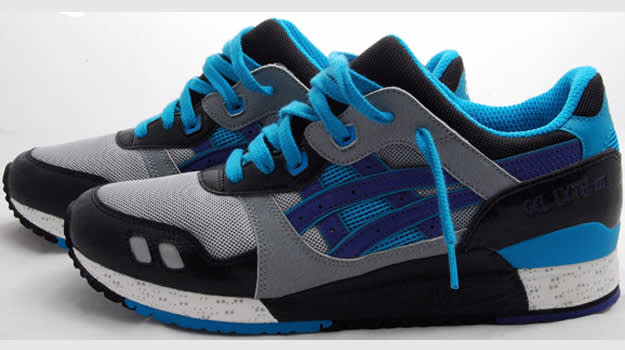
No. 44 - Asics Gel-Lyte III
Year Released: 1990
Asics continues to provide a decent midsole with the GEL technology here in the Lyte III that featured a split tongue that didn't stay around very long.
{C}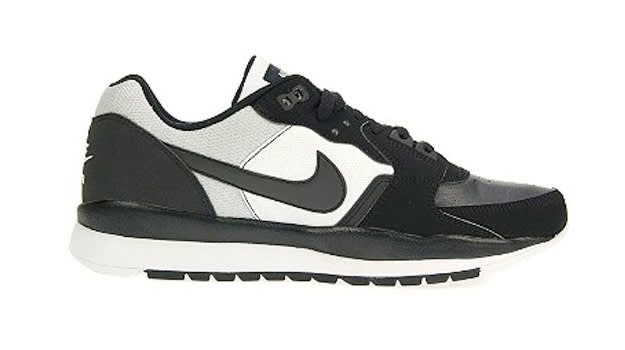
No. 43 - Nike Windrunner
Year Released: 1987
The ‘80s were certainly a type of golden era for Nike running sneakers. Amongst the list of masterpieces shelled out by the Swoosh, the Windrunner was definitely one of the biggest bargains. Generally overlooked as a serious running sneaker, the Windrunner managed to stay true to its name and became one of the most underrated running shoes of all time.
{C} 
No. 42 - Nike Cram Vendetta
Year Released: 1985
Originally a signature shoe for British Olympian Steve Cram, this model built for jogging was especially popular in the UK. What is it about Nike's yellow and black combos that make them so irresistible? With all of the same makeup of middle distance runners at the time, the Vendetta offered stability and support to an otherwise expected running kick.
17.
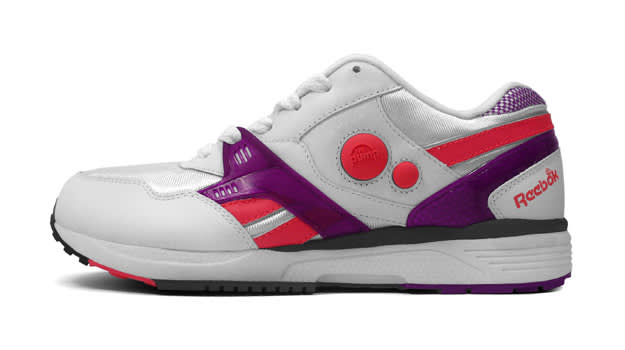
No. 41 - Reebok HXL
Year Released: 1993
The HXL was the first running sneaker to feature the Reebok pump technology. The Pump technology made customization possible, runner were able to control the amount of air supporting them. With just a push of a button, your sneaker was made to fit you, no insole required.
18.
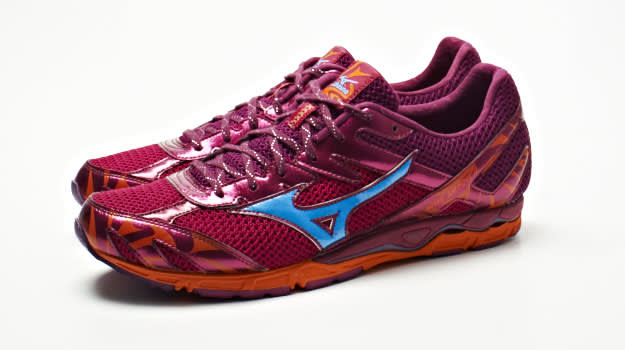
No. 40 - Mizuno Musha 4
Year Released: 2012
The Musha 4 is the mac daddy of racing shoes. With enough midsole to protect heels and arches from the vigors of a long distance race, the super lightweight Musha 4 is an amazing runner with all of the modern necessities of a racer.
19.

No. 39 - adidas Oregon Ultra Tech
Year Released: 1991
With an upper made of synthetic suede and nylon mesh and finised off with reflective trim for nighttime runners, adidas created a classic shock-absorber with the Oregon Ultra Tech, now considered a lifestyle dinosaur of the running past. 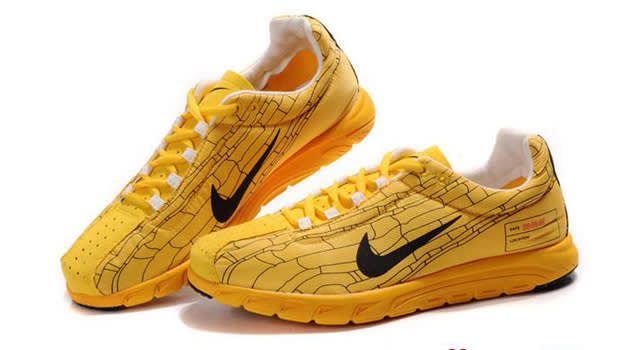
No. 38 - Nike Mayfly
Year Released: 2003
Oddly enough, like the insect from which it gets its name, the Mayfly was designed to last just a day—or 60 miles to be precise. In hopes of creating the lightest and fastest running sneakers, the Nike design team turned to FedEx packaging, which found its way onto the base of the shoe. While it wasn’t very breathable, the wrapping material did hold up against rips, and was even waterproof. Eventually they discovered a more ventilated material that won out.
20.

No. 37 - Saucony Jazz
Year Released: 1981
There are classics, and then there’s the Saucony Jazz—a shoe that we’ll likely still be talking about for decades ahead. With an upper made of nylon and suede for comfort, along with a heavily-patterned outsole for traction, nothing quite like the Jazz had been seen before 1984. It featured the perfect mix of clean lines and great colors, making it an instant success.
21.
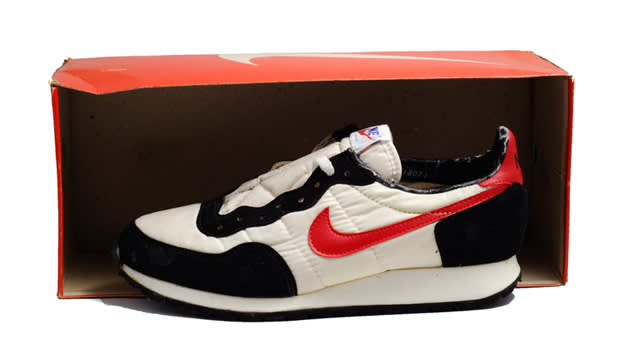
No. 36 - Nike Terra T/C
Year Released: 1981
What started off as a material used for producing teddy bears, soon turned into a revelation for Nike—the result was the Phylon technology we still see in today's Nikes. Unlike urethane, the Phylon midsole didn't break down. While the idea took a bit for people to get used to, there's no question it was a game changer. The T/C stood for training and competition, and was the first running flat designed for both.
{C} 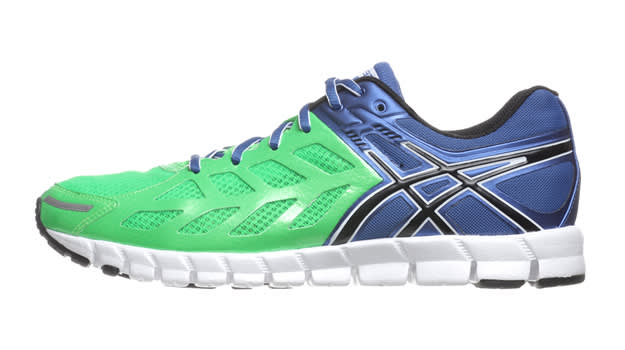
No. 35 - Asics GEL-Lyte33
Year Released: 2012
Asics boasts that this shoe is "lower, lighter, and faster," and we have to agree. The GEL-Lyte33 brings the Solyte midsole to the table which is super responsive without the weigh. Approved by modern running greats like Ryan Hall, the GEL-Lyte is serious favorite for serious runners.
{C} 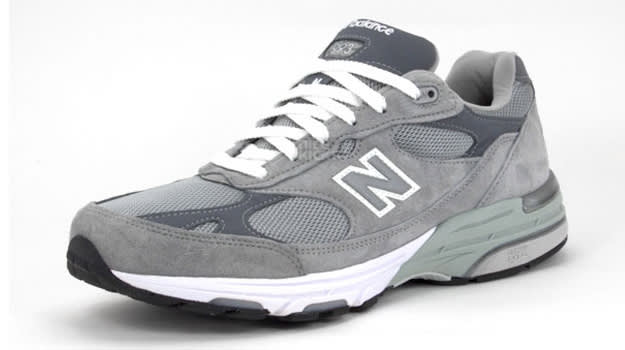
No. 34 - New Balance 991
Year Released: 1999
When a sneaker looks as classy as the New Balance 991 does, it's almost hard to take it seriously in terms of performance. Well, the 991 is an exception to that rule, and in fact, is a favorite amongst the old schoolers. Even Steve Jobs rocked these, so you know they must be good. New Balance's ABZORB cushioning, along with all-terrain capacity made the 991 an instant classic after its release just before the turn of the century.
{C} 
No. 33 - Nike Waffle Racer
Year Released: 1973
Imitation is the sincerest form of flattery. The Nike Waffle Racer knows that first hand. Featuring the famed waffle tread on the rubber outsole, it didn't take long for the Waffle Racer to find success amongst runners looking for a breakthrough sneaker. The shoe became so popular that it inevitably crossed over to the lifestyle dept., and now can most likely even be found (replica of course) at your local J. Crew. But make no mistake about it, at heart, the Waffle Racer has, and always will be a performance sneaker first.
22.
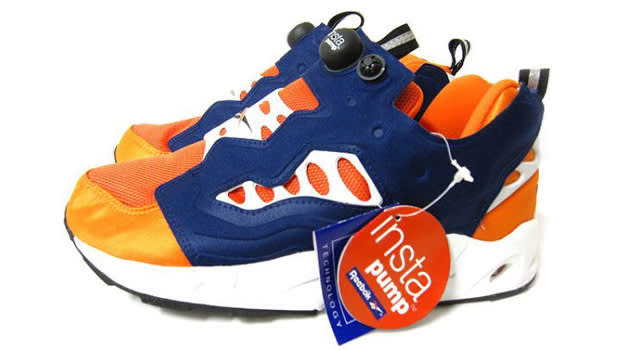
No. 32 - Reebok Insta Pump Fury Road
Year Released: 1994
The lesser-known model to the Reebok Insta Pump Fury as seen on the basketball court, the Road edition came equipped with lugged outsole and extra EVA midsole injection for more wear and tear despite the high maintenence "pump" technology.
23.
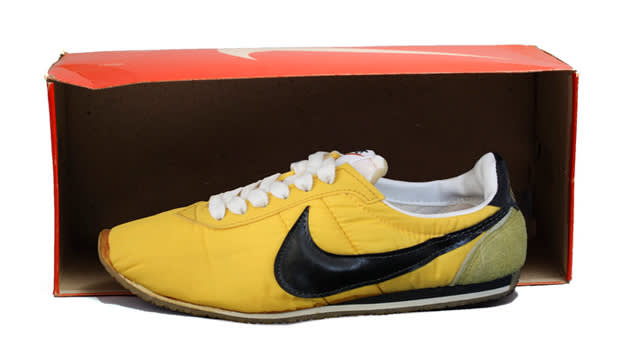
No. 31 - Nike Boston
Year Released: 1973
When talking about legendary running icons, the Nike Boston is certainly in the conversation. Originally going by the Japanese name Obori, It was called Boston only in 1973, when marathon runner John Anderson won the race that took place in the Massachusetts city while wearing a pair. Needless to say, from that moment on, the Boston was a heavy contender. While the first release of the shoe was in blue nylon, the yellow version seen above was released just a few years later.
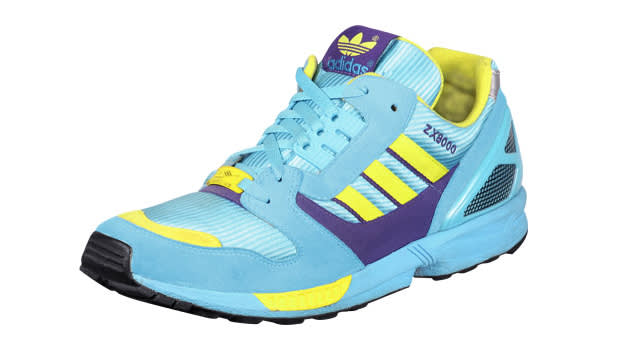
No. 30 - adidas ZX 8000
Year Released: 1989
adidas' Torsion technology became pretty well known in the running world, and it all started with the release of the ZX 8000 in the late '80s. Designed specifically to support the midfoot and allow movement, the ZX 8000 was aimed for serious runners looking to further improve their running techniques.
24.
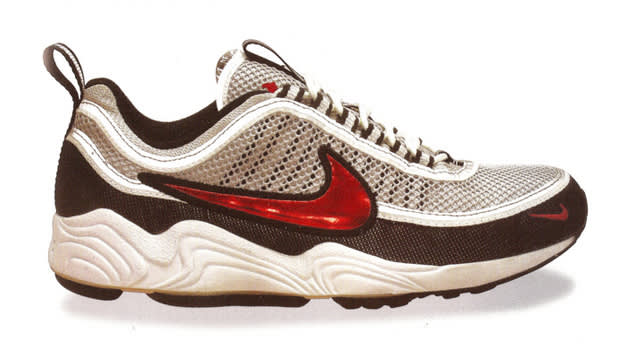
No. 29 - Nike Zoom Spiridon
Year Released: 1997
The Zoom Spiridon was the first Nike running shoe to be blessed with the Nike Air Zoom System. The heaven-sent technology enabled fee to to stay closer to the ground--enhancing performance and providing exceptional cushioning.
25.
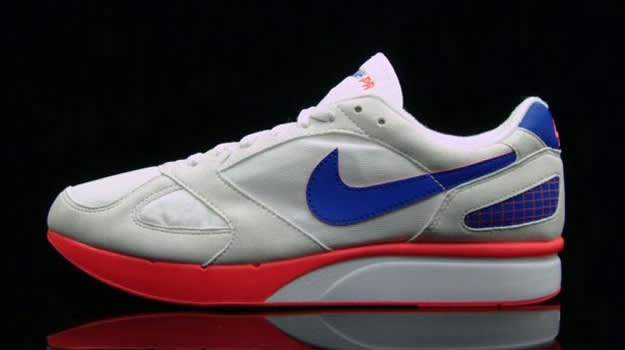
No. 28 - Nike Air Mariah PR
Year Released: 1990
This PR model is a much sought after kick by vintage racer collectors. The Mariah concealed a Nike Air unit in its hefty sole, not to mention the two-toned look that carried over into many Nike racers today.
26.
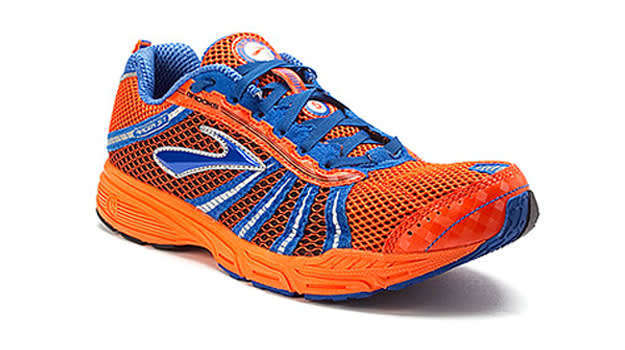
No. 27 - Brooks Racer ST 5
Year Released: 2011
Most racers are minimal, but the Brooks Racer ST 5 has just the right amount of support for a variety of race lengths. The only fault we have with these kicks is they are made in men's sizes only, which means you'll have to match your lady running partner if she has the same excellent tastes you do.
27.

No. 26 - Puma Easy Rider
Year Released: 1982
This sneaker was considered a breakthrough kick with its 1982 debut. The carbonized sole included multiple levels in the PU wedge system, and the outsole design showed grip not previously seen on road racers.
28.

No. 25 - Onitsuka Tiger X-Calibur GT
Year Released: 1982
This shoe was a game changer. Air Flex canals cut into the midsole to create a flexible ride from heel to toe in spite of the extensive cushioning, and a plastic medial post was inserted for pronation control which was a big leap in the evolution of stability sneakers.
29.
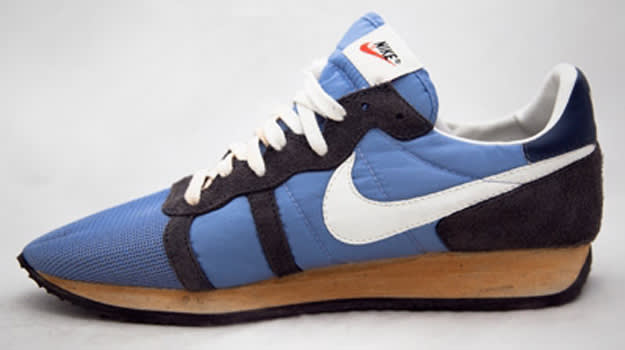
No. 24 - Nike Bermuda
Year Released: 1979
The Nike Bermuda was a pre-cursor to future kicks down the road like the Air Flow and the Air Current, but what earns it a spot on our list is the nylon upper fused with the waffle sole. This kick was ahead of its time when it comes to fusing materials to create a one of a kind kick.
30.
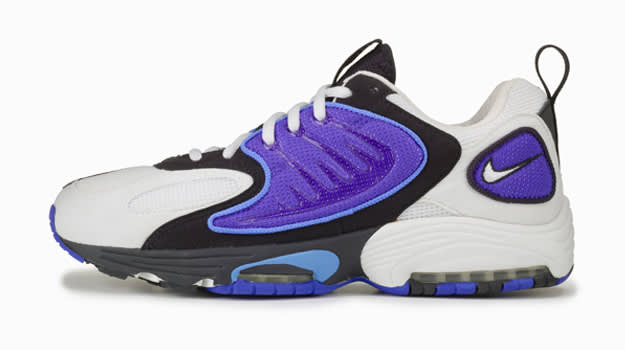
No. 23 - Nike Zoom Citizen
Year Released: 1999
The Zoom Air's tagline was "a flat thin unit that provides low-profile, super-responsive cushioning for top speeds and fast 'off-the mark' movements," a leading technology for the Zoom Citizen. The shoe was apart of Nike's Alpha Project, aimed at amplifying the technical advancements of the lastest performance kicks.
31.
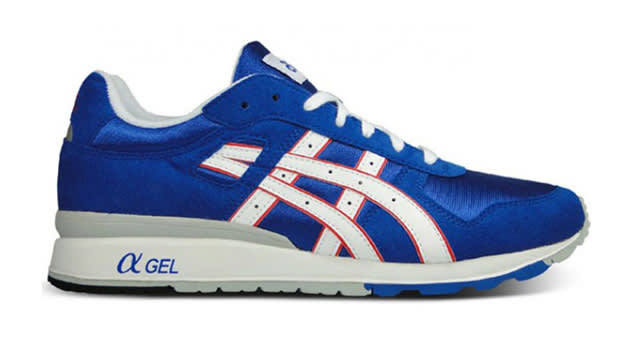
No. 22 - Asics GT II
Year Released: 1986
The Gran Turismo II was the first shoe to include Asics' performance wonder ingredient, the GEL technology. Just take a look at the running collections from Asics today, most of them start with the same three letters that represent a responsive yet supportive midsole. While the GT II wouldn't stand a chance in today's races, the stuff under the hood gave runners plenty to look forward to.
{C} 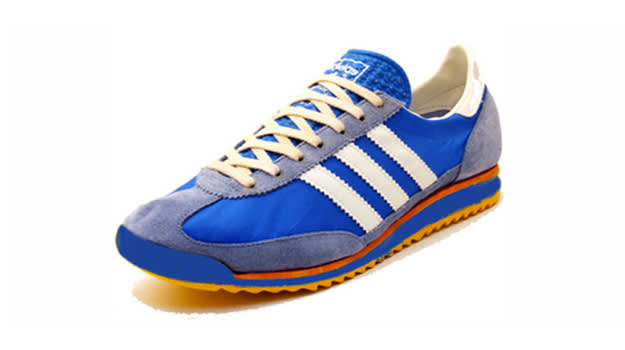
No. 21 - adidas SL 72
Year Released: 1972
The adidas Super Light 72 was ahead of its time in terms of crafting a light shoe that stayed an staple shoe for runners for the next decade. The successful combination of a mesh upper with a suede overlay that wrapped up to the toe was duplicated for years to come.
{C} 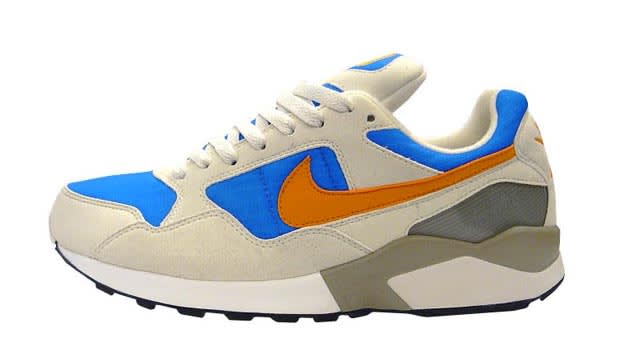 No. 20 - Nike Air Pegasus 92
No. 20 - Nike Air Pegasus 92
Year Released: 1992
The Nike Air Pegasus has generations of kicks for runners to choose from, but the offering from '92 had a sole that is worth mentioning. Before the Shield technology for all-weather conditions or the Nike+ integration of today's Air Pegasus 29, the stability sole offered enough preliminary support for most runners.
{C} 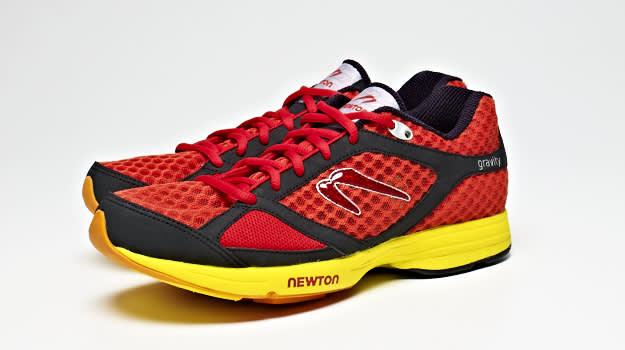
No. 19 - Newton Gravity
Year Released: 2010
The "Gravity" was an obvious choice for a name by the Newton Running company, the outsole construction on this shoe was not. We'll start off with the upper though, which is close to non-existent as a super breathable mesh. The midsole and outsole work together to supply a fast tempo regular run or race kick, weighing in at 9.1 ounces. Newton is known for supporting a natural stride, and now with the Gravity, runners can enjoy a neutral ride on their daily route.
32.

No. 18 - Nike Air Flow
Year Released: 1989
This shoe definitely had a unique look going for it. This lightweight running sneaker featured an encapsulated Air unit in the sole and a nylon upper that screamed summer runs.
33.

No. 17 - adidas EQT Running Support
Year Released: 1992
adidas made big strides in the early '90s to get their foot in first on the technology side. The Guidance System came to be in this age, still featured on most modern day adidas runners. The EQT can definitely serve as a poster child for the sneakers of the day, with the Infinity 3000 rubber outsole and Torsion grip serving runners in need of a little extra support.
{C} 
No. 16 - Nike Air Stab
Year Released: 1988
This short-lived kick (only released for two years!) was an aggressive look and build of the time. The Nike Footbridge stability system in the midsole and the thermoplastic heel counter could only have been created by Tinker Hatfield himself.
{C} 
No. 15 - Nike Cortez
Year Released: 1972
If its good enough for Forest Gump, it's gotta be good enough for us moral runners, right? This kick symbolized the divide between the brands Onitsuka Tiger and Nike, known as Blue Ribbon Sports, as the Cortez was originally known as the Tiger Corsair. The leather model featured just enough midsole to catch the attention of the jogging boom in the early '70s.
{C} 
No. 14 - Brooks PureConnect
Year Released: 2012
Call yourself spoiled after running in this sneaker. The PureConnect supplies enough midsole without ruining your ride, but completely reinvents the experience for runners by connecting the point of impact with the road. Lightweight, flexible, and supportive, the PureConnect will change how you feel about the ride and fit a lighter shoe can provide. The sequel shoe will hit the market this spring, so we're eager to see how Brooks Running can improve on this revolutionary kick.
34.
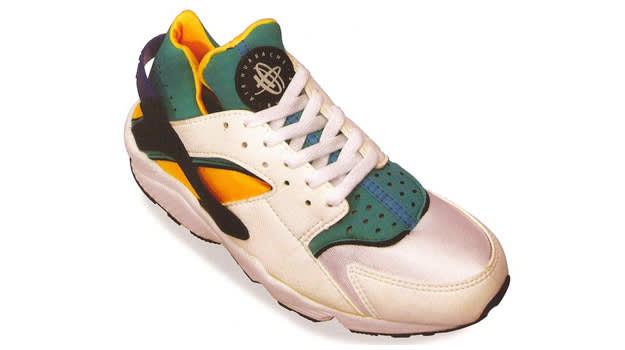
No. 13 - Nike Air Huarache
Year Released: 1991
The Air Huarache was an innovative shoe both in terms of design and fit. The shoe's stretch grip neoprene and spandex provided a glove-like fit for a more natural stride. You wouldn't know it give their collector status today, but the Huaraches were a force to be reckoned with on the run.
35.
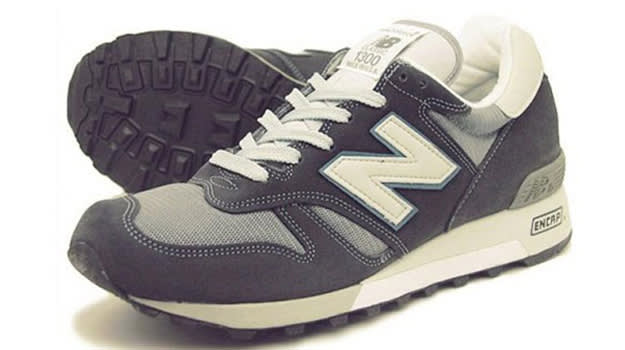
No. 12 - New Balance 1300
Year Released: 1984
You know it’s a good thing when the retro models are still offered for real life use, not just as something to shelve in its original box. The 1300 is a staple of its time, and it’s nice to know that the fans from it’s original release can still pick up a pair. The EVA injected midsole, leather and mesh upper combo, and the solid rubber outsole creates a New Balance classic trainer.
36.

No. 11 - Asics GEL-Noosa Tri 7
Year Released: 2012
The seventh edition of it's show stopping legacy, the GEL-Noosa is designed for triathletes seeking a quick transition, a breathable upper, and a stable ride for the long haul. Using Asic's beloved Guidance System and Solyte technology in the heel and forefoot, the GEL-Noosa will be a triathlete favorite for generations to come.
37.
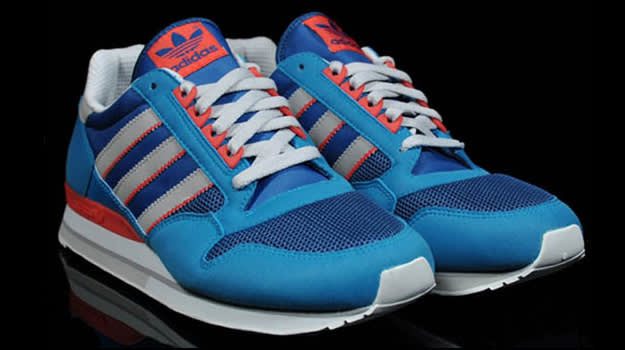
No. 10 - adidas ZX 500
Year Released: 1984
This kick was equipped for some high-milage on the road or the trail. The TPU heel counter and EVA midsole were staples in the industry in the late '80s, and while we have moved on since, these materials were important factors to the evolution to the modern running shoe. All of these components struck a balance in the ZX 500.
{C} 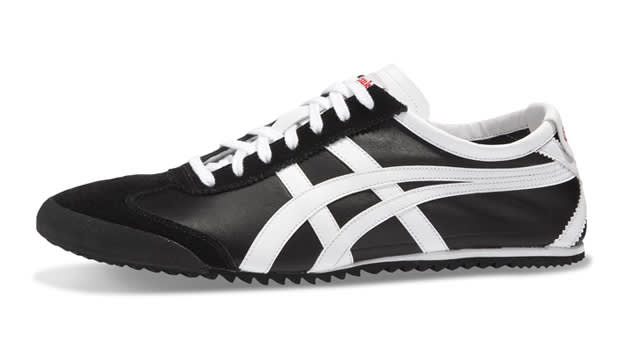
No. 9 - Onitsuka Tiger Mexico
Year Released: 1966
The lightweight upper was the first to boast the Tiger stripes on the side of the shoe. Can you imagine a running shoe, much less, name a shoe that lacks a side panel logo? Didn't think so. The Mexico has it's foothold in more than just the aesthetics department, first released in 1966 this running shoe was a ground breaker.
{C}
38.
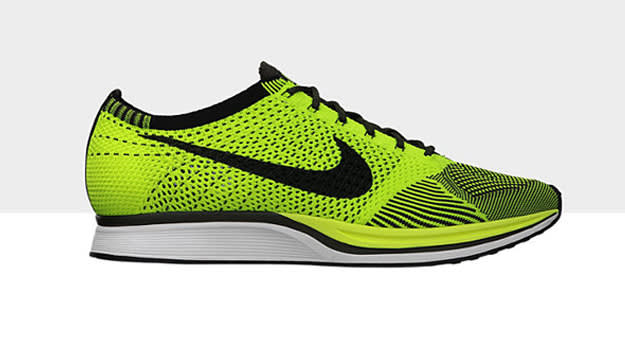
No. 8 - Nike Flyknit Racer
Year Released: 2012
Light for flight is right on. While the idea of a knitted upper might have blown our minds at first, this progression seams—oops— seems like a natural one now. While the rest of the sneakers of 2012 were busy focusing on the midsole / outsole combination to create the lightest functional sneaker possible, Nike decided to focus fully on the upper in a power move known as the Flyknit Racer. While this kick may be more popular with the cool kids then the track team this year, this technology will definitely be a game changer down the road.
{C} 
No. 7 - Mizuno Wave Prophecy
Year Released: 2010
After seven years in the Mizuno lab, the Wave Prophecy was created with a great reception from running community. The out-there look was enough of a show stopper at first, but to follow up with the impressive "natural spring" feeling that the Prophecy supplied was solid gold. We are looking forward to the sequel shoe which could drop any day now, lest Mizuno make us wait another year...
{C} 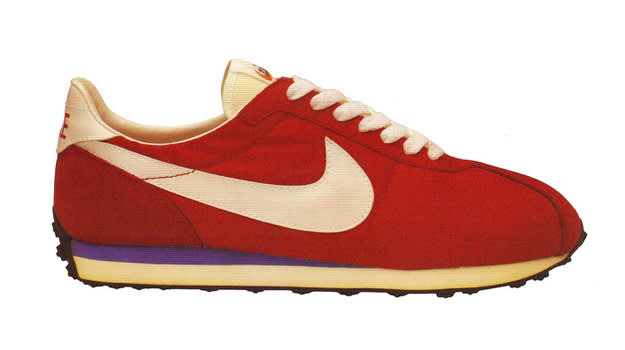
No. 6 - Nike Waffle Trainer
Year Released: 1974
The Waffle Trainer boasts the story of the famed innovation from Bill Bowerman... that one where he probably made his wife thoroughly enraged by pouring plastic into the family waffle iron to create a new outsole texture for his team's track show. This then-unconventional outsole is displayed proudly above on the original Waffle Trainer—making the shoe a beast on any road.
39.
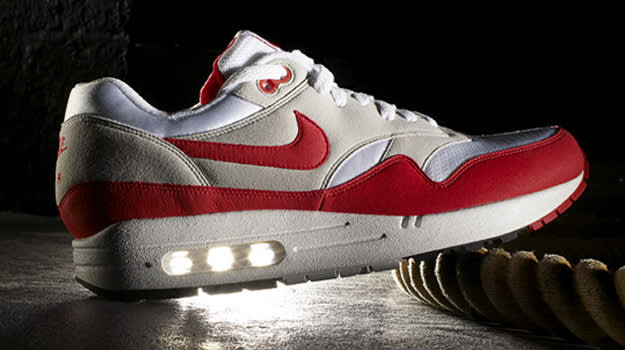
No. 5 - Nike Air Max 1
Year Released: 1987
The Nike Air Max technology was nothing new, but the exposed bubble blew minds 25 years ago. The transparent window that changed performance footwear forever later evolved to create some of runner's favorite models in the '90s, but it was first shown in the Air Max 1. This was a sign of greatness to come from the Swoosh.
40.
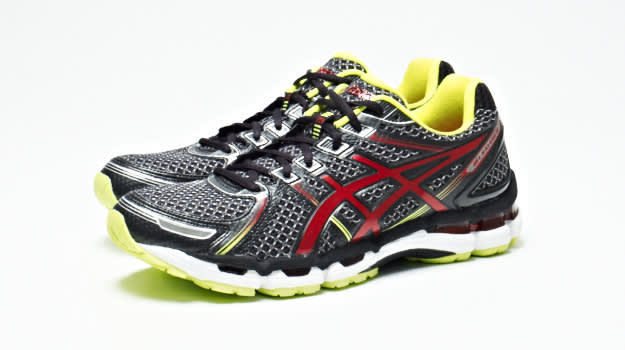
No. 4 - Asics Gel-Kayano 19
Year Released: 2012
This 19th generation of the successful Kayano line re-ups with two key features: significant weight reduction down to 10.9 oz, and an improved fit on the upper—giving this kick the proper assets to keep up with the new kids. 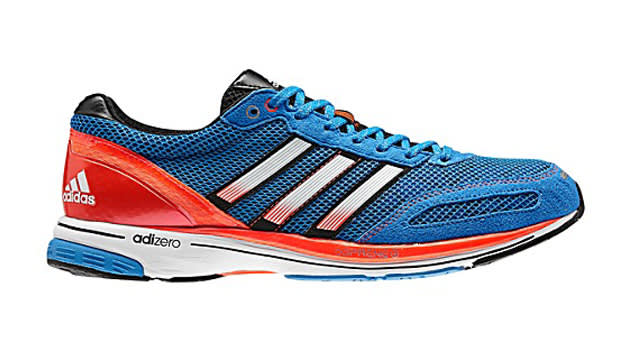
No. 3 - adidas adiZero Adios 2.0
Year Released: 2012
The Adios 2.0 is a racer's favorite. The sneaker weighs just 7.4 oz, and has an air mesh upper and Adiprene underfoot for an efficient ride. This is the sneaker that propelled Patrick Makau to shred records, finishing the Berlin marathon in 2:03:38.
{C}
41.
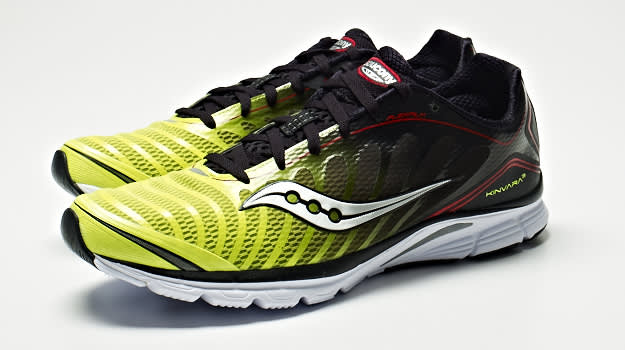
No. 2 - Saucony Kinvara 3
Year Released: 2012
We know it's a bold move to put a running shoe at the top that hasn't yet stood the test of time, but Saucony came to the race looking to win with the Kinvara 3. The latest update to the Kinvara weighs in at 7.7 ounces with a ProGrid midsole to provide a durable, pliable midsole for a comfortable ride. Responsiveness and cushioning strike a perfect balance as your heel is caressed throughout the journey. We at Sneaker Report seriously suggest this sneaker as it is a great introduction to a seriously lightweight build. We'll see how it fairs in sequel editions, but the Kinvara 3 has been one of the most popular shoes spotted at running events in 2012, so we have high hopes for this Saucony kick as running shoes continue to evolve.
42.
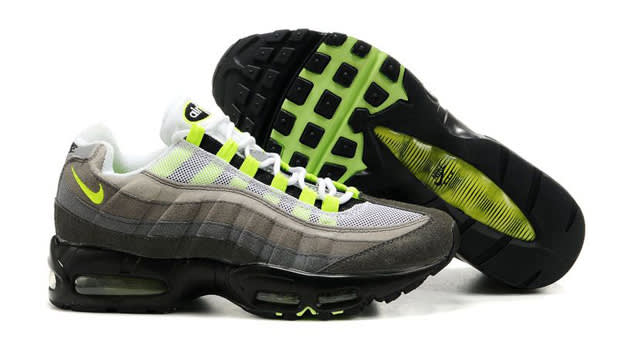
No. 1 - Nike Air Max 95
Year Released: 1995
A sneaker that most of you haven't tried on is better than every shoe you've ever considered running in. What many sneaker historians refer to as the "greatest Nike shoe ever," holds the coveted title of the best running sneaker of all time. With less focus on branding, and more on the performance of the shoe, designer Sergio Lozano used elements from the human body as the basis of his design. The spine was a major point of inspiration which is easy to see in the exposed pocked of the arch outsole and the organic gradation in the upper. With all of the proper ingredients of a stability shoe, the heel-to-toe ride transitions gracefully over the Air Max bubble just as Lozano intended.

